HUNMANBY 2000 YEARS
A BRIEF HISTORY
Ces.Mowthorpe.
(Chairman. Hunmanby Local History Group,)

AD.100-450. Local area populated by two Celtic tribes, mostly the pro-Roman Parisi, but also some anti-Roman Brigantes whose main homeland was further west. Though the Romans began conquering Britain in 43 AD, the north was not fully pacified till the 70s. From then on, settlers from all over the Roman Empire colonised the area, and the Celtic population adopted much Roman culture. By the end of Roman rule (officially 410) this could have included Christianity.
AD.450-1066. Invasion by Anglo-Saxons, then Danes, each bringing their own culture. Settlements formed. Christianity established. Probable Church in Hunmanby.
AD.1066-1100. Norman invasion. Harrying of the North. Gilbert de Gant forms Hunmanby Manor. Domesday. '' One church. One priest.''
AD.1100-1200. Gilbert's son, Walter, founded Bridlington Priory. Conveyed Hunmanby Church with ten Chapels to Bardney Abbey. Lincs. Tower added to Hunmanby church.
AD.1200-1300. Hunmanby vicarage ordained. Richard of Aspignal appointed an independent vicar under Abbot Peter de Barton. Rector and Patron.
AD.1300-1400. Vicar John of Repnyghall died from the Black Death in 1349. Black Death prevalent within the district. Thomas Coke of Hunmanby appointed vicar in 1394.
AD.1400-1500. Vicar Coke was first vicar buried in All Saint's 'quire' (choir) in 1432. Three more vicars from Hunmanby; Geoffrey Kendale (1432-1438); John Story (1438-1449) and John Bele (1449-1465). Changes made to All Saint's Church.
AD.1500-1600. All Saint's church tower was extended and the church bells (3) positioned. The Rectory of Hunmanby, held by the Abbot of Bardney Abbey was valued at Sixty-Four Pounds. Bardney Abbey destroyed by Henry V111. 1538, Hunmanby Church, with its ten Chapels of Ease became independent. The ten chapels were; Burton, Newton, Geldton, Reighton, Fordon, Barkdale, Folethorpe, Muston, Staxton and Ergham. Manors in Hunmanby held by the Westroppe, Percy and Constable families.
AD.1600-1700. Sir Richard Osbaldeston bought Hammerton Manor from brother-in-law Thomas Westroppe.1629. Beginning of the Osbaldeston/Mitford reign, eventually as Lords of the Hunmanby manor, ending in 1920. Sir Richard died 1649. Succeeded by son William, a supporter of Charles 11. Post-restoration (1660) William tried to establish an order 'Knights of the Royal Oak' but this never materialised. William became MP for Scarborough.1685. Christopher Little MA., vicar of Hunmanby and Reighton 1661-82. A plate in All Saint's Church commemorates. Hunmanby Hall is built - a large house in ' Queen Anne Style'.
AD.1700-1800. The Osbaldeston family buy land around Hunmanby with the intention of establishing an agricultural estate. The Stuteville family, reside in the Low Hall Manor House, Sheepdyke Lane. The Driffield canal is completed, opening the way for enclosures of land into large farming estates. Richard Osbaldeston, M.A., second son of Sir Richard Osbaldeston is vicar of Hunmanby (and other parishes) (1715-62). Became Bishop of Carlisle.1747 and Bishop of London in 1762. Followed by Francis Matson. M.A. (1762-85). A metal memorial in All Saint's to Rev.Matson. John Wesley wrote to a friend:- ''I enjoyed great hospitality at Mr Osbaldeston's big house in Hunmanby''.
Humphrey Brooke, grandson of Theodosia Osbaldeston succeeds to the Hunmanby estate, 1783, assuming the name Osbaldeston.
AD.1800-1900. The Volunteers were formed under Humphrey Osbaldeston. An artillery unit, with armoury for their 'big gun' on High Lane. Shoots were directed into Filey Bay. Hence 'Cannon field'. Francis Wrangham, vicar (1795-1843). becoming Archdeacon of Cleveland and the East Riding. A personal friend of William Wordsworth, an educationalist ( forming the first Hunmanby library in All Saint's Church) and founded a school on 'Lancastrian' principles. 1810. Hunmanby population, 1,018. Humphrey Osbaldeston 'enclosed' Hunmanby estate in 1809 fixing roads, fields and farms as they stand today. He added two wings to what now became Hunmanby Hall, enclosed Hall park, closing roads and opening New Road Hill. Roads and buildings cleared to form Cross Hill. Rows of cottages built to house displaced tenants. An estate brickwork's established in Northgate. Railway arrived in 1847. Whitakers brickyard opened alongside Hunmanby railway station. Three ropeworks established. Hunmanby, the post-town for Filey until 1847. Non-conformity arrived with the Baptist church and graveyard in Hungate Lane(1810). Wesleyan Chapel in Stonegate, (1816). Primitive Chapel. Prospect Place, Hungate Lane (1841). Temperance society bought the Wesleyan Chapel in 1870 when the 'new' Wesleyan Chapel was erected in Bridlington Street(1870). Wesleyan Manse and schoolroom were built. Blacksmith Cooper bought and operated a portable steam engine for threshing. Superseded by William Parker who operated Traction engines and Threshing sets. He established the Parker Engineering works and subsequently the first garage. He opened a brickyard, developing kilns for drying, taking over Whitakers brickyard. Mr Cooper's portable steam engine provided power for brickyard machinery.
AD.1900-2000. New village school built 1905. Sir Denis Readett Bayley rented Hunmanby Hall, bought the estate in 1920 and sold immediately to tenants etc. Crosby's Bus Service operates in 1925. Hunmanby Hall school built 1928. Death-watch beetle in church roof - re-roofed in 1930's. Old cottages condemned and demolished. New Council houses built in Hungate Lane/Stonegate and Simpsons Ave., to replace.1939. Butlins Camp commenced building. 1939. Miss L.M.Owston (later J.P. and County Alderman) wrote definitive history of Hunmanby. 1948. Railway spur to Butlins Camp station 1950. Mitford road council estate built 1949. Wrangham Drive built 1950's, followed by the other 'new' estates. New Cross Hill Methodist Chapel opened 1958. Hunmanby Industrial Estate formed in the 1960's. Hunmanby County Primary School opened in 1970's. Butlins Camp closed in the 1980's. Hunmanby Hall closed in the 1990's.
Copyright.1999.
RETURN TO MAIN PAGE